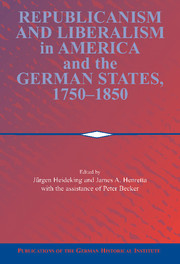Book contents
- Frontmatter
- Introduction
- PART I OVERVIEW
- PART II THE REPUBLICAN WORLD
- PART III THE TRANSITION FROM REPUBLICANISM TO LIBERALISM
- 7 The Liberal and Democratic Republicanism of the First American State Constitutions, 1776-1780
- 8 Bennington and the Green Mountain Boys: The Emergence of Liberal Democracy in Vermont, 1760-1850
- 9 The Birth of American Liberalism: New York, 1820-1860
- 10 Republicanism, Liberalism, and Market Society: Party Formation and Party Ideology in Germany and the United States, c. 1825-1850
- 11 Festive Culture and National Identity in America and Germany, 1760-1860
- 12 Charles Follen’s View of Republicanism in Germany and the United States, 1815-1840
- PART IV THE LOGIC OF LIBERALISM
- Index
7 - The Liberal and Democratic Republicanism of the First American State Constitutions, 1776-1780
Published online by Cambridge University Press: 05 January 2013
- Frontmatter
- Introduction
- PART I OVERVIEW
- PART II THE REPUBLICAN WORLD
- PART III THE TRANSITION FROM REPUBLICANISM TO LIBERALISM
- 7 The Liberal and Democratic Republicanism of the First American State Constitutions, 1776-1780
- 8 Bennington and the Green Mountain Boys: The Emergence of Liberal Democracy in Vermont, 1760-1850
- 9 The Birth of American Liberalism: New York, 1820-1860
- 10 Republicanism, Liberalism, and Market Society: Party Formation and Party Ideology in Germany and the United States, c. 1825-1850
- 11 Festive Culture and National Identity in America and Germany, 1760-1860
- 12 Charles Follen’s View of Republicanism in Germany and the United States, 1815-1840
- PART IV THE LOGIC OF LIBERALISM
- Index
Summary
AMERICAN REPUBLICANISM IN THE CONTEXT OF EUROPEAN LIBERALISM
Why investigate the first American state constitutions for their republican, liberal, and democratic content? Because, together with the Declaration of Independence, they most authentically document the irreversible American commitment to republicanism in 1776. We have no more authoritative statement of the initial American variant of republican government. After a decade of public claims to their rights within the British Empire and over a year after the beginning of armed resistance, the world was given notice by rebellious American colonial political leaders that the extant governments were no longer effective. Within little more than a decade these constitutions became the foundation for a further step of nation building: for the replacement of the Articles of Confederation by the Constitution of the United States, for the evolution from Staatenbund (federation of states) to Bundesstaat (federal state). The Federal Constitution of 1787-91 built on and fulfilled the goals of 1776 to the degree that Southern regional interests permitted. Many of the political institutions and procedures agreed on in the Federal Constitution were derived from or written in reaction to previous experiences with state constitutions.
Only after the successful establishment of a relatively powerful American state was republican, popular, or democratic government – all three terms were used at the time – perceived in Europe as a fundamental challenge to the dominant traditional combination of aristocracy and monarchy. As the German historian Leopold von Ranke explained in a fascinating series of private lectures he gave before the monarchical ruler of Bavaria after the failed revolutions of 1848:
By abandoning English constitutionalism and creating a new republic based on the rights of the individual, the North Americans introduced a new force in the world. Ideas spread most rapidly when they have found adequate concrete expression. Thus republicanism entered our Romanic/Germanic world. . . . Up to this point, the conviction had prevailed in Europe that monarchy best served the interests of the nation. Now the idea spread that the nation should govern itself. But only after a state had actually been formed on the basis of the theory of representation did the full significance of this idea become clear. All later revolutionary movements have this same goal. . . . This was the complete reversal of a principle. Until then, a king who ruled by the grace of God had been the center around which everything turned. Now the idea emerged that power should come from below. . . . These two principles are like two opposite poles, and it is the conflict between them that determines the course of the modern world. In Europe the conflict between them had not yet taken on concrete form; with the French Revolution it did.
- Type
- Chapter
- Information
- Publisher: Cambridge University PressPrint publication year: 2002



